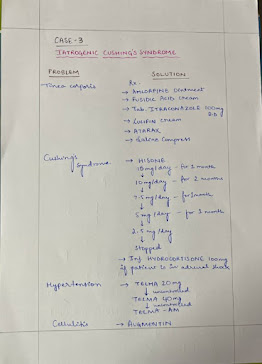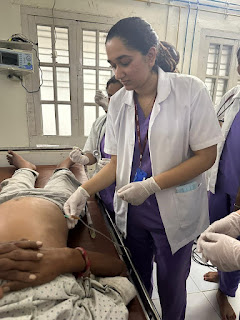CPS - January 2022
I have been given the following Assignment in an attempt to read, comprehend, analyze, reflect upon and discuss captured patient centered data.
QUESTION 1
Please go through one of the case reports in the conference link shared above and provide your critical appraisal of the captured data in terms of completeness, correctness and ability to provide useful leads to analyze the diagnostic and therapeutic uncertainties around the cases shared.
Solution
Positives
1. 1. Ethically sound as the patient is deidentified.
2. 2. Good pictorial representation of the development
of signs and symptoms along with follow up.
3. 3. Case history is well described with proper timeline.
4. 4. Periodic update given on the consecutive results.
Negatives
1. 1. Overall organization of the blog can be improved
3. 2. Personal history is not well explained.
QUESTION 2
Please analyze the linked case report current patient data by first preparing a problem list for each patient in order of perceived priority (based on the shared data) and then discuss the diagnostic and therapeutic uncertainty around solving those problems.
Solution
QUESTION 3
Include the review of literature around sensitivity and specificity of the diagnostic interventions mentioned and same around efficacy of the therapeutic interventions mentioned for each patient and suggest innovative solutions (mentioning how one may design an ethical trial to scale the proposed innovative solution).
Solution
CASE 3: IATROGENIC CUSHING’S SYNDROME
DIAGNOSTIC INTERVENTION :-
ACTH (CORTROSYN) STIMULATION TEST
What is ACTH (Cortrosyn) Stimulation Test?
ACTH (Cortrosyn) stimulation test measures the ability of the adrenal cortex to respond to ACTH by producing cortisol appropriately. ACTH is a hormone produced in the pituitary gland that stimulates the adrenal glands.
What abnormal results mean -
This test is helpful in determining if you have:
l. Addison's disease (decreased adrenal output)
2. Low pituitary function
3. Pituitary tumors
4. Acute adrenal crisis
ACTH stimulation testing presented a 100% sensitivity, a
67.3% specificity, and a 68.6% accuracy
THERAPEUTIC INTERVENTION
The treatment for exogenous Cushing syndrome is
gradual withdrawal of the causative drug, with the aim of discontinuing the
causative drug if possible. An individual with HPA-axis suppression cannot
increase steroid production appropriately during a medical illness or other
stress and should receive stress-dose steroids to avoid adrenal crisis.
Reference :- https://www.uclahealth.org/endocrine-center/acth-stimulation-test
ALTERNATIVE DIAGNOSTIC INTERVENTION :-
LOW DOSE DEXAMETHASONE SUPPRESS TEST (LDDST)
QUESTION 4
Share the link to your own case report this month of a patient that you connected with and engaged while capturing his her sequential life events before and after the illness and clinical and investigational images along with your discussion of that case.
Solution
QUESTION 5
Please reflect on your patient centered experiences that you had while solving their problems this month.
Solution
The COVID-19 pandemic has taken a toll on our college life. As
a 2nd year MBBS student, I have had my fair share of challenges and
hard ships, tried grabbing every opportunity I came across, but none of these
opportunities presented themselves as clinical work, what I was yearning for.
It was an illuminating experience as it helped me understand
the importance of patient education in facilitating improved patient
interaction as sometimes the doctor's oldest tool, i.e, talking to the patient helps in clinical problem solving.


Comments
Post a Comment